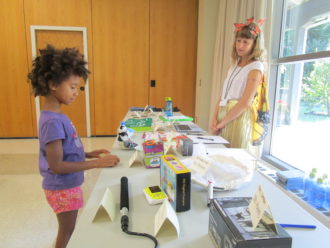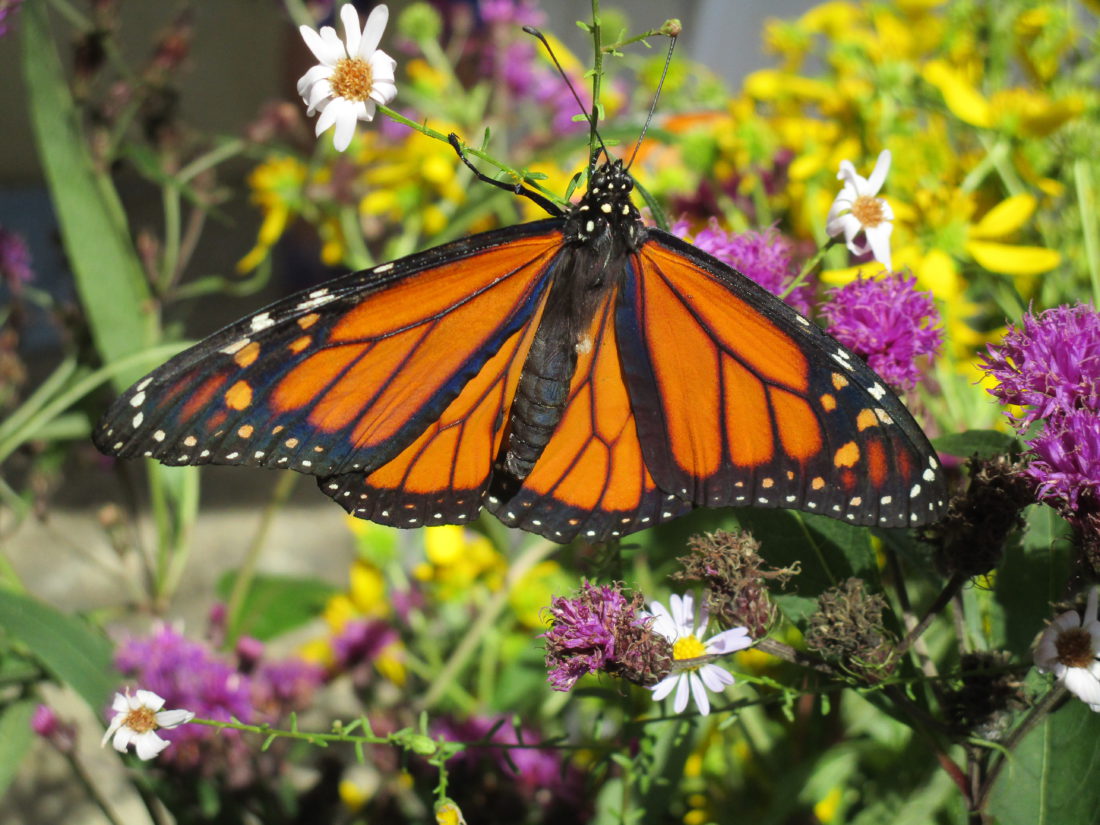You could say learning about monarch butterflies is a gateway drug into conservation.
“I prefer to say ‘gateway organism,’” said Kim Bailey during Monarch Butterfly Day on Sept. 8 at the North Carolina Arboretum. The local monarch enthusiast was wearing a headband adorned with paper butterflies suspended on wires, giving the illusion of a small swarm fluttering above her head.
“Learning about the monarch opens up a whole world of understanding the connections between plants, animals and us,” Bailey said. “It’s the web of life.”
Bailey proclaims herself “obsessed” with the orange and black winged creatures. In 2015, she left her full-time job as an environmental educator with the Georgia Department of Natural Resources to start Milkweed Meadows Farm in Fruitland. The business specializes in producing seeds and plants of the monarch’s most critical food source.
Like many toddlers, monarchs are finicky eaters in their caterpillar phase. They feast exclusively on the leaves of milkweeds, a collection of perennial flowering plants named for their toxic, milky latex. Monarchs have evolved to eat milkweeds safely, and they actually store toxins in their bodies to discourage potential predators.
But the monarch’s choosy eating habit poses a challenge to the survival of the species. Herbicides, farming and parasites have all diminished milkweed habitats. The nonprofit Monarch Watch estimates that around 147 million acres of milkweed, roughly four times the area of the state of Illinois, have been lost to agriculture and development since 1992.
Bailey’s farm provides a Western North Carolina haven for the species, as well as a key supply of milkweed to local seed purveyor Sow True Seed. Through hosting students for educational visits, she also hopes to inspire others to join the monarch’s cause.
“Kids are so important for conservation because they really care,” Bailey said. “And you never know — they could end up quitting their job and starting a milkweed farm some day.”
Helping hands

Fortunately, it doesn’t take a drastic career switch to help the iconic insect. Educators and nature centers are getting kids involved in the national effort to save monarchs from extinction.
The arboretum, for example, coordinates a program called ecoEXPLORE. From June to September, participating children make a real-world impact on ecology research by documenting nature while they’re in the backyard or out visiting nature sites. The kids earn points for each picture taken, which many exchanged on Monarch Butterfly Day for science-themed swag such as binoculars and butterfly nets.
“Scientists need your help. We want to let kids know that they’re involved in conservation, just as much as adults,” said Jonathan Marchal, the arboretum’s youth education manager.
This summer, 80 ecoEXPLORE kids took photos of wildlife, noted details such as time and location, and submitted them to the arboretum. The photo submissions were then vetted, peer-reviewed and made available for public research.
“The kids are really creating a scientific record,” Marchal said. He estimates that participants submitted about 8,000 photos of 1,000 species, including monarchs, during the summer months.
Libbie Dobbs-Alexander, a citizen science specialist with the arboretum, is responsible for sifting through all of those submissions. She says one of the most memorable was a “groundhog selfie,” taken with a remote-activated trail camera, but that most of the photos were of insects.
“We hope that we’re helping encourage them to pursue a career in science,” Dobbs-Alexander says. She adds that the program also aims to get more girls interested and engaged in science and technology fields, in which women are generally underrepresented.
The children’s photos of monarchs can be used to understand butterfly migration patterns. Scientists looking at those individual data points can identify where monarch roosts are being reported and observe how the roosts move south during the autumn.
On the move
“Big questions in ecology take a lot of different researchers to answer,” says Andrew Laughlin, an assistant professor of environmental studies at UNC Asheville.
Laughlin incorporates citizen-science data in his ecology class. His students regularly access the website journeynorth.org to track the monarch butterflies’ migration and learn how seasonal changes influence their behavior.
Every fall, between late September and early October, monarchs make their way from the Northeastern U.S. to Mexico. Prime butterfly viewing can be found in the Blue Ridge Mountains, where the pollinators stop by wildflowers for sips of nectar along their way south.
The coming of autumn alerts the monarchs that it’s time for their Mexican siesta. But scientists are still trying to understand precisely how the warming climate and extreme weather events are affecting their migration and population. That’s where citizen-science data, which pinpoints subtleties like location, time of day and temperature, can be helpful for revealing the bigger picture.
“If given enough data over a large enough time span, we could start to see patterns forming, and we can start to see the influence of climate on organisms over a large scale,” Laughlin says.
Flutter for the future

Beyond the ecoEXPLORE celebration, Monarch Butterfly Day featured a discussion with an entomologist, a milkweed seed-bomb craft and a butterfly tagging and release in the garden. The tags, tiny stickers, adhere to a “mitten-shaped” vein on the monarch’s lower wing. The stickers don’t affect flight, and they bear unique tracking numbers. In theory, a researcher in Mexico’s highlands could document a monarch that flew the more than 2,000-mile journey from Asheville.
Monarch Watch annually distributes more than 250,000 of the small tracking stickers to citizen-science efforts, giving scientists another data point to understand the survival rate of the tiny migrants. By looking up the tracking number, researchers can learn how far a monarch traveled and how long the journey took, as well as determine changes in the overall distribution among butterflies that arrived at roosting sites in Mexico.
The monarch’s annual cross-country flight contributes to its charisma in the eyes of its human admirers. But fewer butterflies are making the trip these days. The U.S. Fish and Wildlife Service estimates that the monarch population in the Eastern U.S. fell from roughly a billion in 1996 to just 33 million in 2014. While the research community agrees that factors like habitat loss are contributing to the declines, they’re still trying to pinpoint what exactly is driving the numbers.
That’s where the efforts of citizen scientists and kids are making a real impact on preservation work. Conservationists and educators say that gives them hope. “Often, all you have to do is tell them, ‘There may be a day when there are no monarch butterflies,’” Marchal said. “Who wouldn’t have a sad feeling that comes over them by hearing that? Certainly these kids are going to want to do something.”



Before you comment
The comments section is here to provide a platform for civil dialogue on the issues we face together as a local community. Xpress is committed to offering this platform for all voices, but when the tone of the discussion gets nasty or strays off topic, we believe many people choose not to participate. Xpress editors are determined to moderate comments to ensure a constructive interchange is maintained. All comments judged not to be in keeping with the spirit of civil discourse will be removed and repeat violators will be banned. See here for our terms of service. Thank you for being part of this effort to promote respectful discussion.